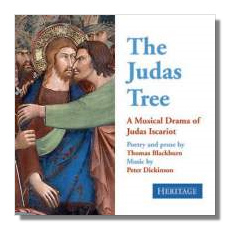
The Internet's Premier Classical Music Source
Related Links
- Dickinson Reviews
- Latest Reviews
- More Reviews
-
By Composer
-
Collections
DVD & Blu-ray
Books
Concert Reviews
Articles/Interviews
Software
Audio
Search Amazon
Recommended Links
Site News
 CD Review
CD Review
Peter Dickinson

The Judas Tree
A Musical Drama of Judas Iscariot
The Washington National Cathedral Production, March 1967
Poetry and Prose by Thomas Blackburn (1916-1977)
Two tenor soloists: narrator and commentator
SATB chorus: thirty voices or more
Instrumentation: string quartet, string bass, two trumpets, horn, two trombones, organ, piano, percussion: timpanist and three other percussionists (Written for student performers)
Heritage HTGCD263 70m
This is a powerful drama reinforced by powerful and original music. There is nothing hackneyed about either.
The drama is in three parts and includes prose monologue, seven numbered choruses and four numbered fanfares, a short musical Introduction and a musical Epilogue. Some of the choruses are from the Gospel of Matthew and from Psalm 129 (De profundus) and the Agnus Dei in Latin and English, reminiscent of both the gospel passages in Vaughan Williams Hodie and also reminiscent of Britten's War Requiem, to which this work has been compared. Mostly, the choruses are the poetic work of Blackburn. Blackburn's daughter, in the notes to the CD, credits her father with putting "seventeen major heresies" into his text, not to mention fictionalized liberties with the biblical account a bit comparable to Britten's account of Abraham and his son.
The Introduction is loud, appropriately dissonant, even chaotic. The monologue in Part I is by Pontius Pilate, initially accompanied by very soft bass melody; he is presented as still living after two millennia and addressing the audience as a "detached observer" but actually in a pompous and self-justifying manner. Judas is presented as somewhere between life and death, unable to die. Pilate suggests that "it is high time we did something for Judas" who got "a raw deal…in a put-up job." He is interrupted by striking fanfares for trumpets and percussion, as well as three times by the chorus, which has a great deal to sing about. The manner of the singing is quite varied, and so is the accompaniment to it. Initially the singing is lively, and later is more of a staccato chant. One section is briefly introduced by the horn; another passage is accompanied quietly by a gong. By the end the chorus is singing softly and beautifully in the background, with quiet organ accompaniment. Pilate is interrupted by a speaker from the chorus at one point, and the Evangelist Matthew more than once. The chorus also cries out "Crucify him," with the referent seemingly, at first, and later, in Part III, explicitly, to Judas. Pilate ends Part I by suggesting that Judas' betrayal was "by no means wholly negative," an implied comparison with the "felix culpa" of Adam and Eve which medieval theologians came up with, and a phrase which occurs in Britten's Ceremony of Carols. After we hear the last of Pilate, there is a third fanfare, with brass, drums and cymbals.
Part II begins with the sound of wire brushes sweeping piano strings followed by a prayer sung by the chorus. Then a Dominican friar speaks of, and administers, the rite for the dying, while a semi-chorus sings Psalm 29 and the Agnus Dei, followed then by the full chorus singing a song about the dead with oblique references to the mythical River Styx. Chorus and Dominican alternate short passages, all in Latin. The phrasing and rhythms of the chorus in this section are arresting, with some quiet pizzicato string accompaniment, and becoming reminiscent of rhythmic styles of Bernstein and Stravinsky. Judas comes to a groggy consciousness while the chorus sings Requiem aeternum, etc. The chorus leader confronts him with "betrayest the Son of Man with a kiss?" and Judas stumbles off the stage. Fanfare IV, ending Part II is portentous, clanging, anything but upbeat.
Part III is something entirely different. We are among Nazis. The chorus sings of the night of the long knives, making reference also to the "Minotaur and Medusa, the vampire and were-wolf (God's unacknowledged children), the gas chamber and blood on the leaves of the Judas Tree." A German commandant calls out marching orders to a squad. A voice sounds, "Father, into thy hands…" and the Commandant orders three rounds at the "targets by the wall." The shots are realistically sounded, seemingly by a thunder sheet or a tam tam. The Commandant summons Judas, who is affirmed as a loyal member of the Party, and is given a special mission to identify Jesus Christ in Gethsemane. He agrees, but first addresses Christians in lengthy self-justification as one "destined to further the Divine intention by the betrayal of the Son of God." He also tells the audience that he must himself "go the way of the cross." First, though, he demands money and is made to grovel on the ground for it. The chorus sings a lamentation. When the Commandant demands to know where is Jesus, Judas responds, "Any man, everyman, who is not that man?" The Commandant cries, "So, you are, so, I know you…Thou art the Man." The Chorus cries "Crucify him …crucify him." Judas, in raising his arms in the form of a cross, says "It is finished."
The Musical Epilogue includes the organ and is dissonant.
The program notes with the CD make an unnecessary apology for the age of the sound in the recording; not everything is crystalline, but the speakers in particular come across very clearly and enunciate impeccably. The notes also include comments by Thomas Blackburn, and Julia Blackburn, his daughter. They give the performance history of this work, with quotes from reviews in Financial Times, The Scotsman, the Times Educational Supplement, Music and Musicians, The Washingon Post, The Washington Star and The Musical Quarterly.
The praise in those reviews is well deserved. Highly recommended.
Copyright © 2014, R. James Tobin















